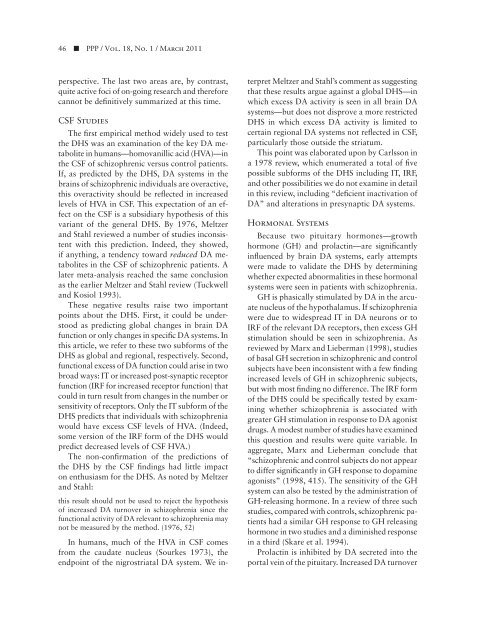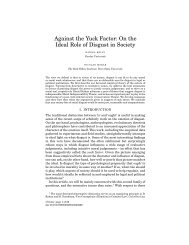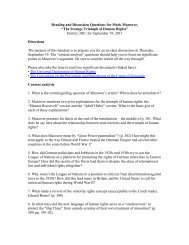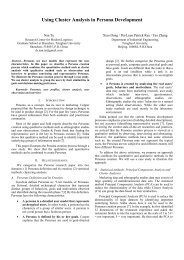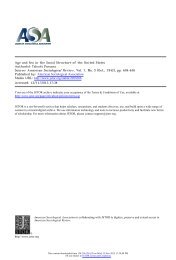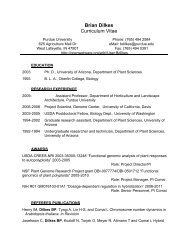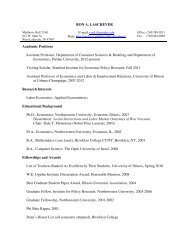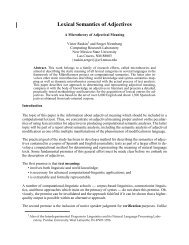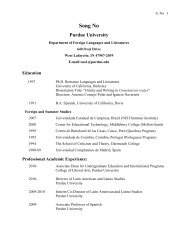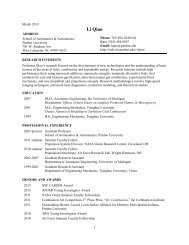The Dopamine Hypothesis of Schizophrenia: An Historical and ...
The Dopamine Hypothesis of Schizophrenia: An Historical and ...
The Dopamine Hypothesis of Schizophrenia: An Historical and ...
Create successful ePaper yourself
Turn your PDF publications into a flip-book with our unique Google optimized e-Paper software.
46 ■ PPP / Vol. 18, No. 1 / March 2011<br />
perspective. <strong>The</strong> last two areas are, by contrast,<br />
quite active foci <strong>of</strong> on-going research <strong>and</strong> therefore<br />
cannot be definitively summarized at this time.<br />
CSF Studies<br />
<strong>The</strong> first empirical method widely used to test<br />
the DHS was an examination <strong>of</strong> the key DA metabolite<br />
in humans—homovanillic acid (HVA)—in<br />
the CSF <strong>of</strong> schizophrenic versus control patients.<br />
If, as predicted by the DHS, DA systems in the<br />
brains <strong>of</strong> schizophrenic individuals are overactive,<br />
this overactivity should be reflected in increased<br />
levels <strong>of</strong> HVA in CSF. This expectation <strong>of</strong> an effect<br />
on the CSF is a subsidiary hypothesis <strong>of</strong> this<br />
variant <strong>of</strong> the general DHS. By 1976, Meltzer<br />
<strong>and</strong> Stahl reviewed a number <strong>of</strong> studies inconsistent<br />
with this prediction. Indeed, they showed,<br />
if anything, a tendency toward reduced DA metabolites<br />
in the CSF <strong>of</strong> schizophrenic patients. A<br />
later meta-analysis reached the same conclusion<br />
as the earlier Meltzer <strong>and</strong> Stahl review (Tuckwell<br />
<strong>and</strong> Kosiol 1993).<br />
<strong>The</strong>se negative results raise two important<br />
points about the DHS. First, it could be understood<br />
as predicting global changes in brain DA<br />
function or only changes in specific DA systems. In<br />
this article, we refer to these two subforms <strong>of</strong> the<br />
DHS as global <strong>and</strong> regional, respectively. Second,<br />
functional excess <strong>of</strong> DA function could arise in two<br />
broad ways: IT or increased post-synaptic receptor<br />
function (IRF for increased receptor function) that<br />
could in turn result from changes in the number or<br />
sensitivity <strong>of</strong> receptors. Only the IT subform <strong>of</strong> the<br />
DHS predicts that individuals with schizophrenia<br />
would have excess CSF levels <strong>of</strong> HVA. (Indeed,<br />
some version <strong>of</strong> the IRF form <strong>of</strong> the DHS would<br />
predict decreased levels <strong>of</strong> CSF HVA.)<br />
<strong>The</strong> non-confirmation <strong>of</strong> the predictions <strong>of</strong><br />
the DHS by the CSF findings had little impact<br />
on enthusiasm for the DHS. As noted by Meltzer<br />
<strong>and</strong> Stahl:<br />
this result should not be used to reject the hypothesis<br />
<strong>of</strong> increased DA turnover in schizophrenia since the<br />
functional activity <strong>of</strong> DA relevant to schizophrenia may<br />
not be measured by the method. (1976, 52)<br />
In humans, much <strong>of</strong> the HVA in CSF comes<br />
from the caudate nucleus (Sourkes 1973), the<br />
endpoint <strong>of</strong> the nigrostriatal DA system. We interpret<br />
Meltzer <strong>and</strong> Stahl’s comment as suggesting<br />
that these results argue against a global DHS—in<br />
which excess DA activity is seen in all brain DA<br />
systems—but does not disprove a more restricted<br />
DHS in which excess DA activity is limited to<br />
certain regional DA systems not reflected in CSF,<br />
particularly those outside the striatum.<br />
This point was elaborated upon by Carlsson in<br />
a 1978 review, which enumerated a total <strong>of</strong> five<br />
possible subforms <strong>of</strong> the DHS including IT, IRF,<br />
<strong>and</strong> other possibilities we do not examine in detail<br />
in this review, including “deficient inactivation <strong>of</strong><br />
DA” <strong>and</strong> alterations in presynaptic DA systems.<br />
Hormonal Systems<br />
Because two pituitary hormones—growth<br />
hormone (GH) <strong>and</strong> prolactin—are significantly<br />
influenced by brain DA systems, early attempts<br />
were made to validate the DHS by determining<br />
whether expected abnormalities in these hormonal<br />
systems were seen in patients with schizophrenia.<br />
GH is phasically stimulated by DA in the arcuate<br />
nucleus <strong>of</strong> the hypothalamus. If schizophrenia<br />
were due to widespread IT in DA neurons or to<br />
IRF <strong>of</strong> the relevant DA receptors, then excess GH<br />
stimulation should be seen in schizophrenia. As<br />
reviewed by Marx <strong>and</strong> Lieberman (1998), studies<br />
<strong>of</strong> basal GH secretion in schizophrenic <strong>and</strong> control<br />
subjects have been inconsistent with a few finding<br />
increased levels <strong>of</strong> GH in schizophrenic subjects,<br />
but with most finding no difference. <strong>The</strong> IRF form<br />
<strong>of</strong> the DHS could be specifically tested by examining<br />
whether schizophrenia is associated with<br />
greater GH stimulation in response to DA agonist<br />
drugs. A modest number <strong>of</strong> studies have examined<br />
this question <strong>and</strong> results were quite variable. In<br />
aggregate, Marx <strong>and</strong> Lieberman conclude that<br />
“schizophrenic <strong>and</strong> control subjects do not appear<br />
to differ significantly in GH response to dopamine<br />
agonists” (1998, 415). <strong>The</strong> sensitivity <strong>of</strong> the GH<br />
system can also be tested by the administration <strong>of</strong><br />
GH-releasing hormone. In a review <strong>of</strong> three such<br />
studies, compared with controls, schizophrenic patients<br />
had a similar GH response to GH releasing<br />
hormone in two studies <strong>and</strong> a diminished response<br />
in a third (Skare et al. 1994).<br />
Prolactin is inhibited by DA secreted into the<br />
portal vein <strong>of</strong> the pituitary. Increased DA turnover


